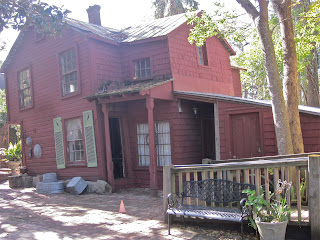I took the camera with me on my last walk thru the Campground.
An evolving blog full of all the things I love. Photography, Painting, Cooking. And sharing with all of the people in my life that mean the world to me.
Friday, November 30, 2012
Dow Museum of Historic Houses - St. Augustine, FL
 |
| This is a diagram of the property that I found online. |
Some background: Within the borders of the Dow Museum of Historic Houses, one city block contains more than 400 years of St. Augustine history. Among the courtyards and gardens, visitors can view archaeological records of a sixteenth-century hospital and cemetery, an eighteenth-century Spanish Colonial defense line, and the site of the 1863 reading of the Emancipation Proclamation which freed all of the slaves in Florida. Kenneth Worcester Dow was born in 1911. He first travelled to St. Augustine in the 1930s. Thoroughly enjoying his visit, he made St. Augustine his permanent home - and purchased the oldest house on the property, the 1790 Prince Murat House. By the early 1950s, Mr. Dow had acquired all nine historic homes on the block. Mr. Dow generously donated his entire collection of artwork, furniture and other antiques to the Museum of Arts & Sciences in Daytona Beach, FL, in 1989. The Dow Museum of Historic Houses was opened in late 2000 after 11 years of restoration.
Link: http://www.moas.org/dowmuseum.html
Here are the pictures that we took:
 |
| Dow House [1839] also above |
 |
| See the face? |
 |
| I popped my head inside and took this picture [Carpenters House] |
 |
| and this one [Carpenter's House] |
 |
| 1906 [Worcester House] |
 |
| [Worcester House] |
Thursday, November 29, 2012
St Augustine: The Town Wall, The Public Burying Ground & Zero Milestone of Old Spanish Trail
 |
| Two years later in 1704, the Spanish began construction of the Cubo line, a powerful earthen wall backed by palmetto logs. From the outworks of the Castillo de San Marcos, the wall extended west across the northern end of town to the San Sebastian River. Along this line were the main gates to the city and several larger fortifications called redoubts. The redoubts added extra power to the line and provided locations for artillery emplacements. |
 |
| 19th Century Mill, built in 1888 |
 |
| The Old Spanish Trail (the OST) was an auto trail that once spanned the United States with a full 3,000 miles (4,800 km) of roadway from ocean to ocean. It crossed eight states and 67 counties along the southern border of the United States. Work on the auto highway began in 1915 at a meeting held at the Battle House Hotel in Mobile, Alabama, and, by the 1920s, the trail linked St. Augustine, Florida, to San Diego, California, with its center and headquarters in San Antonio, Texas. The cities in between boasted a shared heritage of Spanish missions, forts and Spanish colonization. |
 |
| Zero Milestone of the Spanish Trail |
Wednesday, November 28, 2012
Visitor Map 11/15 - 11/18/12
Historic St Augustine
Subscribe to:
Comments (Atom)
An Additional note to my Chicken Marsala for One Recipe
https://blueskyahead.blogspot.com/2020/11/chicken-marsala-for-one.html I made this again a month ago, and I was not impressed. So I made ...

-
Uncle Fred's Catering 3 Lazy R Chuck Wagon 897 Rd 156 Pine Bluffs, WY 82082 307-245-3339 307-214-4674 Cell Wood@rtconnect...
-
This is a diagram of the property that I found online. 149 Cordova St, Some background: Within the borders of the Dow Museum of Histor...
-
I cooked a whole chicken in the crockpot for 8 hours. Let it cool and deboned it. I'm going to use the Campbell's Skillet Sauces, ...









































